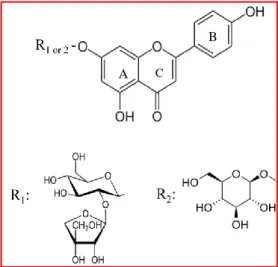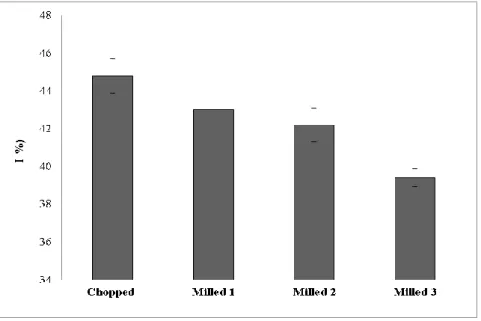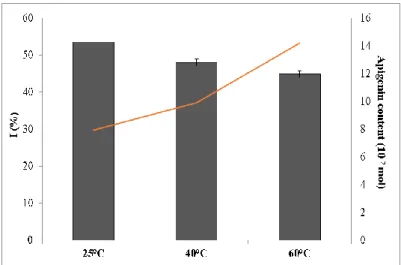STUDY ON THE ANTIOXIDANT ACTIVITY DURING THE FORMULATION OF BIOLOGICAL ACTIVE INGREDIENT
Zsófia Edit Pápay, PharmD, István Antal, PharmD.,PhD
Department of Pharmaceutics, Semmelweis University, Budapest, Hungary
Abstract
Background& Aims:This study examined the antioxidant activity of different extract of parsley (Petroselinum crispum) with DPPH method. This assay is one of the most commonly used because of its simplicity and efficiency. Parsley is a widely known culinary plant and herbal medicine in Europe since ancient times. It is easy to grow and many biological activities are attributed to the flavonoids in the leaf. Biological active herbal medicines have an advantage over drugs because they are safer and cheaper. Methods: The antioxidant activities of the main flavonoid and its glycosides were measured. With previously optimized extraction procedure, the effect of particle size and extraction temperature were tested regarding the radical scavenging activity and drug content with spectrophotometric and HPLC-UV method. The antioxidant capacity of the extracts for 7 days were also investigated. Results: The aglicon possesses bigger antioxidant activity over the glycosidic forms. The scavenging activity was decreased with smaller the particle size of the dried leaves and higher temperature, but the flavonoid content was increased.
Conclusion: The use of medicinal plants in the therapy is emerging. The exact dose and mode of action of the medicinal plants are still an unfolding area therefore the study on the main mode of action - the antioxidant activity – influenced by the formulation is important.
Keywords: Parsley, Petroselinum crispum, flavonoids, antioxidant activity, DPPH assay
Introduction
Reactive oxygen species are generated in the body as a result of the cellular metabolism and eliminated by defensive ezymes like superoxide dismutase (SOD). When the cellular production of ROS is increased or the endogen antioxidant capacity is decreased, oxidative stress can occur (Thannickal and Fanburg 2000, Ray, Huang et al. 2012). Several malfunctions and diseases are related to this mechanism e.g. diabetes and neurodegeration (Simonian and Coyle 1996, Schaffer, Jong et al. 2012). It has proven to be involved in cardiovascular diseases like artherosclerosis (Li, Horke et al. 2013) and even in the development of cancer (Chiang, Wang et al.). The ROS can damage proteins, lipids and DNA; downstream signaling molecules and trigger cellular death by apoptotic pathways in the cell. They have also been identified as key factors in drug and toxin induced organ pathophysiology (Rashid, Sinha et al. 2013).
In the recent years, the medicinal plants have drawn interest against oxidative stress. The presence of various, natural antioxidants in herbs are well known. Phenolic compounds, especially flavonoids, can donate hydrogen to the harmful free radicals to prevent the oxidative damage at the first initiation step. They are not only scavenging radicals, but inhibiting their genesis (Nijveldt, van Nood et al. 2001).
Parsley (Petroselinum crispum) is a widely known culinary plant and herbal medicine in Europe since ancient times. It is easy to grow and many biological activities are attributed
253
to its seed and leaf. The consumption of the leaf is beneficial to cardiovascular and diabetic diseases via anti-inflammatory, anti-hyperlipidimic and anti-hyperglycemic properties (Yanardag, Bolkent et al. 2003). The advantages are mainly related to the flavonoids and their antioxidant activity but the synergistic effect of all chemicals are important in the therapy (Fejes, Blázovics et al. 2000, Wong and Kitts 2006, Zhang, Chen et al. 2006).
Flavonoids are diverse group of polyphenolic compounds with diverse health effects.
Apigenin and its glycosides (apiin and apigenin-7-O-glycoside) (Figure 1.) are the main flavonoids in parsley in high quantities (Database 2014, May). It was reported to have antioxidant, antiinflammatory and anticancer activities which makes parsley a preventive and therapeutic herbal medicine in cancer therapy (Shukla and Gupta 2010).
Figure 1. Structure of apigenin and its glycosides R1: apiin R2: apigenin-7-O-glycoside
The objective of this study was to examine the changes the main mode of actions - the antioxidant activity and apigenin content – of the parsley extract influenced by the formulation with DPPH method. This assay is one of the most commonly used because of its simplicity and efficiency.
Materials
The dried parsley leaves were purchased in a local grocery store (Kotányi Hungária Kft., Budapest, Hungary). The DPPH (2,2-Diphenyl-1-picrylhydrazyl), apigenin and its glycosides (apigenin-7-O-glycoside, apiin) were obtained from Sigma-Aldrich Ltd.
(Germany). For the HPLC analysis, the acetonitrile was supplied by Sigma-Aldrich Ltd.
(Germany) and the water was purified using Milli-Q water system (Millipore, Germany). The ethanol was ordered from Molar Chemicals Kft. (Hungary).
Methods
Preparation of Petroselinum crispum extract
The dried and chopped parsley leaves were milled with Retch Mixer Mill MM 400 (Germany) at 10, 15, 25 1/s frequency with 10 pieces of 1 cm diameter balls for 30 seconds.
The particle size values of d(0,1), d(0,5) and d(0,9) of the samples were analyzed by laser diffraction Malvern Mastersizer 2000 (Malvern Industries, Germany).
The extraction of apigenin and other antioxidants were carried out under constant stirring (500 rpm, ARE Heating magnetic stirrer, VELP Scientifica, Italy) with 50:50 (%, v/v) ethanol:water mixture at 25°C, 40°C and 60°C for 90 min. The extraction procedure (solvent to solid ratio, solvent mixture and strirring) was based on the literature to obtain the highest
A C
B
total apigenin content (Luthria 2008). All samples were filtered through paperfilter (Sartorius AG, Germany) to remove the parsley leaves.
To compare the scavenging activity of the apigenin and glycosides 0.1 mg/ml ethanolic stock solution were prepared.
Radical scavenging activity
The free radical scavenging activity of extracts were measured using DPPH method as described by Hatano et al. (1988) with slight modifications. 2 ml of 0,1 mMDPPH reagent in ethanol was added to 0,1 ml of each sample diluted with 0,9 ml ethanol. Thereafter the samples were vortex mixed for 10 seconds and incubated for 30 min in the dark at room temperature. The absorbance was measured at 517 nm. To calculate the inhibition of the free radical DPPH the following equation was used:
Where I (%) the inhibition in percent, A0 the absorbance of the DPPH solution and As the absorbance of the sample. All measurements were carried out triplicate and the data were expressed as the mean value ± SD.
Analytical Conditions
The total apigenin content of the samples was measured by HPLC-UV method. All samples were hydrolyzed for 1 hour at 37°C with 37% HCl. To ensure that the apigenin remain stable during hydrolysis, the same procedure was carried out with apigenin stock solution (0,1 mg/ml in ethanol). The analysis was performed on Agilent 1100 Series HPLC equipped with diode array detector (Agilent Technologies Inc., USA). A Supelco C18, 15cm x 4.6 mm, particle size 3 µm column was employed for the separation. The column temperature was set to 25 °C. The isocratic mobile phase consist of acetonitrile and 0.1 M ammonium acetate in 40:60 (w/w %) ratio. The flow rate was 0.8 mL/min, injection volume was 20 µl. The spectral data were recorded at 340 nm for 7 minutes. The data were evaluated with HP Agilent ChemStation A 10.02 computer program.
The absorption data refering to the antioxidant activity were measured by UV-1650PC Shimadzu spectrophotometer (Japan) connected to a PC for data processing (Shimadzu UV- probe program).
Results and Discussion
The radical scavenging activity of the main flavonoid apigenin and its glycosides were tested. Figure 2. shows that the
aglicon molecule (without sugar moiety) has the highest activity which can be attributed to lack of sugar components on C7-OH group. There are two main structure activity relationship which has a role in the radical scavenging activity of flavonoids: the dihydroxy structure in ortho position in the B ring (which forms H-bond with the radicals) and the C2-C3 double bond in conjugation (which is responsible for the electronic delocalization starting from the B ring due to the 4-oxo functional group in the C ring)
I (%) = ((A0-As)/A0) x100
Figure 2. Antioxidant activity of apigenin and its
255
(Leopoldini, Pitarch et al. 2003). In the human body the glycosides are hydrolyzed into aglicons by bacterial and human β- glucosidase enzymes, which enhance the absorption throught the gastrointestinal tract (Day, DuPont et al. 1998).
Table I. Effect of grinding on the particle size (µm)
The aqueous ethanolic extract of Petroselinum crispum showed H-donor activity.
Flavonoids and other chemicals like carotenoids and vitamins can contribute to radical scavenging activity. Reducing the particle size of parsley leaves before the extraction decreased the inhibition of DPPH (Figure 3.) as well as the extraction at higher temperature.
The possible explanation can be the damage of the heat sensitive antioxidant compounds e.g.
Vitamin C. As Table I. shows, the size of dried leaves can be easily reduced even into µm range, therefore the generated heat or structural changes during milling can affect these molecules.
However the total antioxidant activity is decreasing, the apigenin content is increasing during extraction at higher temperature (40 °C and 60 °C) as can be seen on Figure 4. The temperature has a significant impact on the phenolic content of the parsley extracts (Luthria 2008). Several studies showed strong correlation between phenolic content and antioxidant activity (Velioglu, Mazza et al. 1998, Dorman, Kosar et al. 2003) but different results were obtained in this study which indicates that not only the flavonoids can contribute to the scavenging effect. However, the flavonoids, like apigenin has other beneficial effects.
d (0,1) d (0,5) d (0,9) 10 0.192 0.451 3.227 15 0.154 0.295 1.634 25 0.141 0.238 0.509
Figure 3. Effect of grinding on antioxidant activity Milled 1: 10, Milled 2: 15, Milled 3: 25 1/s frequency for 30 s
While the scavenging activity is the result of various chemicals, the effectiveness of the plant extract is strongly affected by the stability of the molecules. Figure 5. indicates the decreasing activity during storage at room temperature and in the fridge as well as the result of decomposition.
Conclusion
Naturally occurring molecules with antioxidant activity can have a possible therapeutic application against oxidative damage induced diseases. In a complex system of bioactive ingredients, the therapeutic effects are the result of the synergistic effect of various compounds. Herbal medicines have an advantage over drugs because they are safer and cheaper, thus their pharmaceutical application is increasing. However, the exact dose and mode of action are still an unfolding area, therefore it is important to invesigate the influential factors on the main mode of action – the antioxidant activity – during the formulation. This study confirms the antioxidant potential of parsley (Petroselinum crispum) extract which is influenced by particle size and temperature. Further work should be conducted regarding the chemicals responsible for the scavenging activity and formulation parameters.
Figure 4. Effect of temperature on antioxidant activity and apigenin content during extraction
Figure 5. Investigation of the antioxidant activity at 4°C and 25°C
for 7 days
257
References:
Chiang, F.-F., H.-M. Wang, Y.-C. Lan, M.-H. Yang, S.-C. Huang and Y.-C. Huang "High homocysteine is associated with increased risk of colorectal cancer independently of oxidative stress and antioxidant capacities." Clinical Nutrition(0).
Database, U. (2014, May). "USDA Database for the Flavonoid Content of Selected Foods, Release 3.1."
Day, A. J., M. S. DuPont, S. Ridley, M. Rhodes, M. J. Rhodes, M. R. Morgan and G.
Williamson (1998). "Deglycosylation of flavonoid and isoflavonoid glycosides by human small intestine and liver beta-glucosidase activity." FEBS Lett 436(1): 71-75.
Dorman, H. J., M. Kosar, K. Kahlos, Y. Holm and R. Hiltunen (2003). "Antioxidant properties and composition of aqueous extracts from Mentha species, hybrids, varieties, and cultivars." J Agric Food Chem 51(16): 4563-4569.
Fejes, S., A. Blázovics, É. Lemberkovics, G. Petri, É. Szöke and Á. Kéry (2000). "Free radical scavenging and membrane protective effects of methanol extracts fromAnthriscus cerefolium L. (Hoffm.) andPetroselinum crispum (Mill.) Nym. ex A. W. Hill." Phytotherapy Research 14(5): 362-365.
Leopoldini, M., I. P. Pitarch, N. Russo and M. Toscano (2003). "Structure, Conformation, and Electronic Properties of Apigenin, Luteolin, and Taxifolin Antioxidants. A First Principle Theoretical Study." The Journal of Physical Chemistry A 108(1): 92-96.
Li, H., S. Horke and U. Förstermann (2013). "Oxidative stress in vascular disease and its pharmacological prevention." Trends in Pharmacological Sciences 34(6): 313-319.
Luthria, D. L. (2008). "Influence of experimental conditions on the extraction of phenolic compounds from parsley (Petroselinum crispum) flakes using a pressurized liquid extractor."
Food Chemistry 107(2): 745-752.
Nijveldt, R. J., E. van Nood, D. E. van Hoorn, P. G. Boelens, K. van Norren and P. A. van Leeuwen (2001). "Flavonoids: a review of probable mechanisms of action and potential applications." Am J Clin Nutr 74(4): 418-425.
Ray, P. D., B.-W. Huang and Y. Tsuji (2012). "Reactive oxygen species (ROS) homeostasis and redox regulation in cellular signaling." Cellular Signalling 24(5): 981-990.
Schaffer, S. W., C. J. Jong and M. Mozaffari (2012). "Role of oxidative stress in diabetes- mediated vascular dysfunction: Unifying hypothesis of diabetes revisited." Vascular Pharmacology 57(5–6): 139-149.
Shukla, S. and S. Gupta (2010). "Apigenin: a promising molecule for cancer prevention."
Pharm Res 27(6): 962-978.
Simonian, N. A. and J. T. Coyle (1996). "Oxidative stress in neurodegenerative diseases."
Annu Rev Pharmacol Toxicol 36: 83-106.
Thannickal, V. J. and B. L. Fanburg (2000). "Reactive oxygen species in cell signaling." Am J Physiol Lung Cell Mol Physiol 279(6): L1005-1028.
Velioglu, Y. S., G. Mazza, L. Gao and B. D. Oomah (1998). "Antioxidant Activity and Total Phenolics in Selected Fruits, Vegetables, and Grain Products." Journal of Agricultural and Food Chemistry 46(10): 4113-4117.
Wong, P. Y. Y. and D. D. Kitts (2006). "Studies on the dual antioxidant and antibacterial properties of parsley (Petroselinum crispum) and cilantro (Coriandrum sativum) extracts."
Food Chemistry 97(3): 505-515.
Yanardag, R., S. Bolkent, A. Tabakoglu-Oguz and O. Ozsoy-Sacan (2003). "Effects of Petroselinum crispum extract on pancreatic B cells and blood glucose of streptozotocin- induced diabetic rats." Biol Pharm Bull 26(8): 1206-1210.
Zhang, H., F. Chen, X. Wang and H.-Y. Yao (2006). "Evaluation of antioxidant activity of parsley (Petroselinum crispum) essential oil and identification of its antioxidant constituents."
Food Research International 39(8): 833-839.



